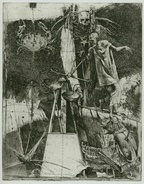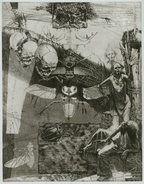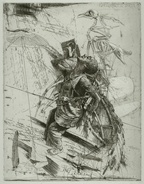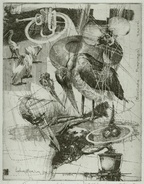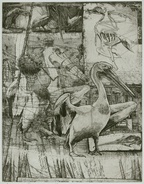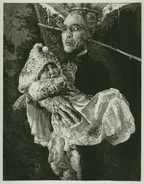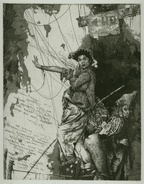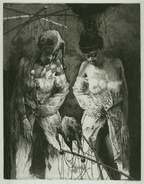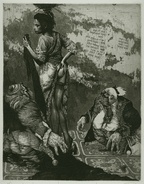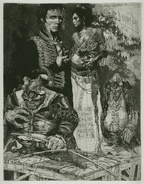ALEXANDER STESHENKO
|
Etchings | Drawings | Watercolor | Paintings Commercial art | Sketches | Digital Paint Artist contact |
||||||||||||||||||||||||||||||||||||||||||||||||||||||||||||||||
Etching. In pure etching, a metal (usually copper, zinc or steel) plate is covered with a waxy ground which is resistant to acid. The artist then scratches off the ground with a pointed etching needle where he or she wants a line to appear in the finished piece, so exposing the bare metal. The plate is then dipped in a bath of acid, technically called the mordant (French for "biting") or etchant, or has acid washed over it. The acid "bites" into the metal, where it is exposed, leaving behind lines sunk into the plate. The remaining ground is then cleaned off the plate. The plate is inked all over, and then the ink wiped off the surface, leaving only the ink in the etched lines. The plate is then put through a high-pressure printing press together with a sheet of paper (often moistened to soften it). The paper picks up the ink from the etched lines, making a print. The process can be repeated many times; typically several hundred impressions (copies) could be printed before the plate shows much sign of wear. ОФОРТ - разновидность и техника гравюры на металле, в которой углубления печатной формы создаются травлением поверхности металла кислотой. Полированную металлическую "доску" из меди покрывают слоем кислотоупорного лака. Такой лак приготовляют из смеси асфальта (битума), канифоли и воска. Лак наносят кожаным тампоном на горячую доску. После затвердевания лака его поверхность коптят, чтобы на темном фоне лучше были видны процарапанные штрихи и лак набрал прочность. Потом на доску переводят (под давлением либо с помощью кальки) подготовительный рисунок. Затем офортной иглой лак процарапывается до поверхности металла - линии и штрихи хорошо видны на фоне темного лака, после чего осуществляют травление. Доску загрунтовывают сзади жидким лаком и травят в азотной кислоте (разбавленной водой). При травлении штрихи углубляются. Последовательно добавляя рисунок к уже протравленным местам и продолжая травление, можно варьировать глубину травления. Затем покрывной лак смывают бензином и скипидаром. Печать осуществляют аналогично резцовой гравюре, втирая черную печатную краску в углубления штрихов (выступающие части доски тщательно вытирают калькой для получения чистого фона). Печать осуществляют на специальном офортном прессе. Под давлением краска переходит на влажную (подготовленную) бумагу. | |||||||||||||||||||||||||||||||||||||||||||||||||||||||||||||||||
